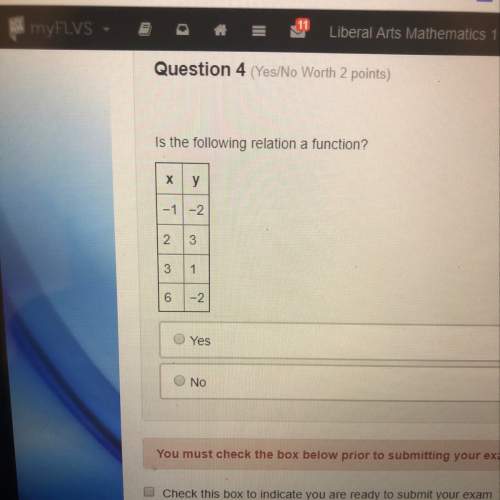
Mathematics, 14.12.2020 23:00 burnsmykala23
On a coordinate plane, 2 quadrilaterals are shown. Quadrilateral A B C D has points (2, negative 2), (4, negative 2), (3, negative 4), and (1, negative 4). Quadrilateral J K L M has points (4, negative 4), (8, negative 4), (6, negative 9), and (2, negative 9). Is quadrilateral JKLM the result of a dilation of quadrilateral ABCD by a scale factor of 2? Why or why not? Yes, because sides JK and ML are twice as long as sides AB and DC. Yes, because both figures are parallelograms, so corresponding sides are parallel. No, because sides JK and ML are not twice as long as sides AB and DC. No, because sides JM and KL have different slopes from sides AD and BC.

Answers: 3


Another question on Mathematics


Mathematics, 21.06.2019 20:20
Tomas used 3 1/3 cups of flour and now has 1 2/3cups left. which equation can he use to find f, the number of cups of flour he had to begin with? f+3 1/3=1 2/3 f-3 1/3=1 2/3 3 1/3f=1 2/3 f/3 1/3=1 2/3
Answers: 1

Mathematics, 22.06.2019 00:10
Will mark the brainliest.paula makes stained-glass windows and sells them to boutique stores. if her costs total $12,000 per year plus $4 per window for the frame. how many windows must she produce to earn a profit of at least $48,000 in one year if she sells the windows for $28 each?
Answers: 1

Mathematics, 22.06.2019 03:40
Let f of x equals the integral from 1 to 3 times x of the natural logarithm of t squared. use your calculator to find f″(1).
Answers: 1
You know the right answer?
On a coordinate plane, 2 quadrilaterals are shown. Quadrilateral A B C D has points (2, negative 2),...
Questions



Mathematics, 10.07.2019 12:30


Biology, 10.07.2019 12:30


Mathematics, 10.07.2019 12:30







Advanced Placement (AP), 10.07.2019 12:30


Mathematics, 10.07.2019 12:30

Business, 10.07.2019 12:30






